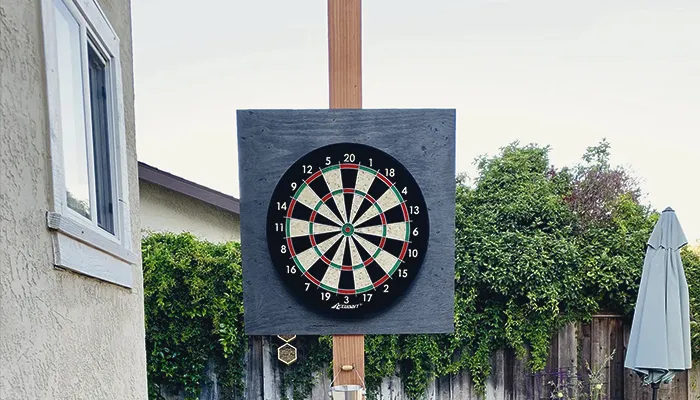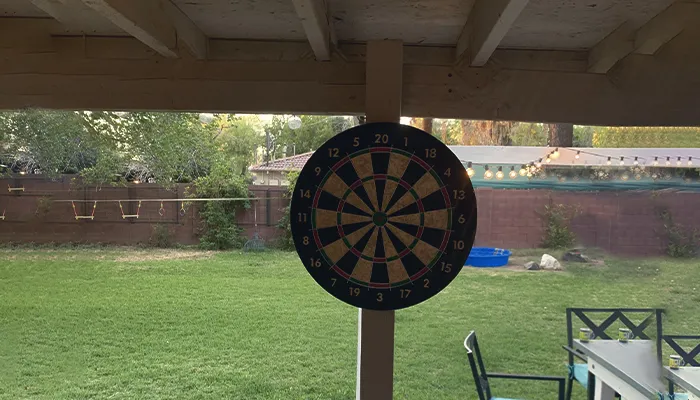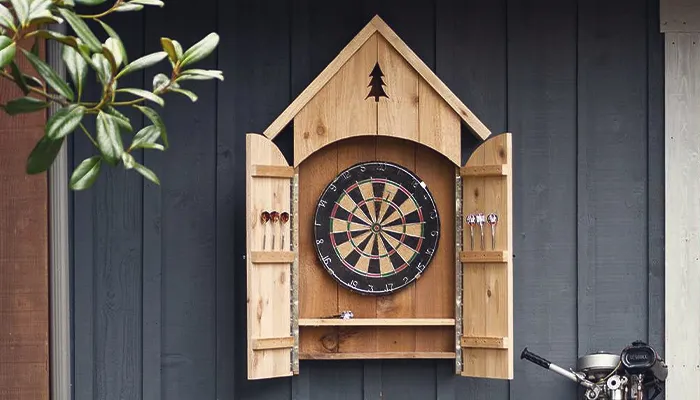So you’ve decided to move your dart-throwing outside, have you? Great choice – nothing beats enjoying a few rounds of darts in the fresh air. But before you start drilling holes in your siding, take a minute to consider the perfect spot.
You’ll want somewhere that gets plenty of natural light so you can see what you’re aiming at, but avoid direct sunlight which can make darts harder to throw accurately. Look for a spot at least 10 feet away from the house so wayward darts don’t end up stuck in the vinyl.
And make sure there aren’t any windows, plants or other items in the line of fire that could get damaged. By putting in a little planning now, you’ll have a prime position picked out and be throwing bullseyes in your own backyard in no time.
Choosing the Right Outdoor Location for a Dartboard
The ideal spot for your outdoor dartboard is crucial. You want a location that’s convenient, safe, and provides the right conditions for accurate throws.
Look for a spot with a solid wall at least 5 to 6 feet wide. Brick, stone or concrete is best, but wood can also work if it’s at least 1 inch thick. Just make sure there aren’t any windows nearby! The wall should be in a spot that gets plenty of shade to avoid weathering.
You’ll also want a level area for standing and throwing, so check that the ground is even and flat. And consider the direction you’ll be throwing from – you don’t want the sun glaring in your eyes!
Safety is key, so choose a spot away from walkways or seating areas. Make sure there’s enough space behind the board for wayward darts to safely land. You’ll want at least 10 to 15 feet between the board and the ground.
Mount the board about 5 feet high for most adults, and slightly lower for kids. Secure it firmly so there’s no danger of it falling after repeated dart impacts.
With the perfect location and a properly mounted board, you’ll be hitting bullseyes in your own backyard in no time. But remember, safety comes first – so choose wisely and set clear rules to ensure fun for all. Your pals will thank you for a well-placed dartboard and an accident-free game!

How to hang a dartboard outside
Hanging a dartboard outside calls for some careful planning. The last thing you want is for your board to end up warped, faded or – worse yet – broken after the first major storm.
Location
First, find a spot that’s sheltered from the elements. An area under an awning, patio or gazebo is ideal. If that’s not possible, at least choose a wall that doesn’t face the prevailing wind.
You’ll also want an area that gets lots of natural light during the day so you have good visibility, but avoid direct sunlight which can damage the board. North or east-facing walls are best.
Secure It Well
Next, you need to mount the board securely. For brick, stone or concrete walls, masonry anchors or wall shields with bolts are your best option. Wood or vinyl siding can handle screws, as long as you sink them into the studs behind the siding.
If privacy fencing or railings are your only choice, you may need to construct a wooden frame to provide a sturdy mounting surface. In a pinch, you can also hang a board from sturdy tree branches, using strong rope, chain or wire. Just make sure to pad the area around the board well in case of bounce-outs or wild throws!
With the proper precautions taken, you’ll be throwing darts in the great outdoors in no time. But don’t forget the most important step: throw safely and responsibly. Keep areas around the board clear, never throw when others are downrange retrieving darts, and always exercise caution. Enjoy your new outdoor game!

Protecting Your Dartboard From the Elements
To keep your outdoor dartboard in good condition, you’ll need to take steps to protect it from exposure to the elements. The sun, wind, and rain can all cause damage over time if left unchecked.
Shield from Sunlight
Extended exposure to direct sunlight can cause the sisal fibers in the dartboard to weaken and break down. To avoid sun damage, place the board in a spot that doesn’t receive full sun for most of the day.
An area with dappled shade from trees or a spot that’s shaded in the afternoon is ideal. If that’s not possible, you can construct a simple canopy over the board using wood boards or PVC piping and outdoor fabric or a tarp.
Block the Wind
Strong winds won’t do your dartboard any favors either. The constant buffeting can loosen staples and cause the wiring and sisal fibers to fray more quickly. Hang the board on a wall or sturdy post in an area that’s protected from direct wind, like a covered patio or carport.
If hanging it from a tree, place it on the side facing away from the prevailing wind. You can also install temporary wind barriers like reed fencing, lattice, or slat walls on the windward sides of the dartboard.
Keep Rain at Bay
Getting soaked in a downpour will severely damage an outdoor dartboard. Never mount the board in an open, uncovered area where rain can reach it. The best options are under an overhang, in a garage or shed, or on a covered patio or deck.
You’ll also want to avoid spots where rainwater runoff flows or drips onto the board. When rain is in the forecast, consider covering the board with an outdoor tarp or board cover to keep it dry.
Taking steps to shield your dartboard from sunlight, wind, and rain will help keep it in tip-top shape for many matches to come. With the proper protection and periodic maintenance, an outdoor dartboard can provide years of entertainment.

Lighting Considerations for Outdoor Dartboards
When hanging a dartboard outside, lighting is an important factor to consider for optimal play.
Position Near an Existing Light Source
If possible, locate your dartboard near an outdoor light that’s already installed, like a porch light. This will illuminate the board for evening games without requiring additional installation. Just make sure the light is centered over the board or behind the throw line so it does not create shadows that could interfere with aiming.
Install Overhead Lighting
For the best visibility, install an overhead light directly above the center of your dartboard. A bright LED floodlight or spotlights are good options. Mount the light at least 8 to 10 feet high to avoid glare in the players’ eyes. This type of direct lighting eliminates shadows and ensures the entire board is clearly lit.
Use Multiple Lights
For larger outdoor areas or if overhead lighting is not possible, utilize multiple lights around the board. Place a light behind each corner of the board and possibly one behind the throw line.
This surround lighting brightens the board from all sides and reduces shadows. Using dimmer switches on the lights allows you to control the brightness and create the perfect ambiance for your game.
Consider the Darkness of the Area
The level of lighting needed depends on the existing level of darkness in your yard. More open areas away from buildings and foliage will require more substantial lighting, especially for late night games.
Shady, enclosed patios may only need minimal additional lighting for daylight or early evening dart playing. Think about when you are most likely to use the board and choose appropriate lighting that will make all parts of the board clearly visible during those times.
With the proper lighting in place, your outdoor dartboard setup will be ready for fun and competitive play any time of day or night.
Focus the lighting directly on the board and consider the natural darkness of your location to determine how much extra light is really needed. Following these tips will help ensure clear aiming and high scores at your next outdoor dartboard match.
Safety Tips for Hanging a Dartboard Outside
When hanging a dartboard outside, safety should be a top priority. Follow these tips to ensure everyone’s wellbeing.
Choose a Safe Location
Pick a spot that’s away from windows, siding, and any other areas where stray darts could cause damage. An open space like a garage, shed, or fenced-in yard is ideal. Make sure the area behind the board is clear for at least 10 to 15 feet so darts have room to fly and fall without hitting anything.
Install a Backboard
Attach a large piece of plywood, corkboard, or pegboard behind the dartboard to prevent darts from penetrating the wall. Secure the backboard to wall studs or beams for stability. The backboard should extend at least 2 to 3 feet on all sides of the dartboard.
Consider a Dart Catcher
Place a dart catcher, backstop, or net behind the board to catch any darts that miss the board completely. A dart catcher helps ensure darts do not end up on the ground where people could step on the sharp points.
Mount the Board at Regulation Height
For steel-tip darts, mount the board so the bullseye is 5 feet 8 inches high. This is regulation height and will allow players to stand the proper distance from the board. Make sure the board is level for the most accurate throws.
Enforce Safety Rules
Establish and enforce rules to keep everyone safe like:
•Always throw darts from behind the throw line.
•Never throw darts when others are retrieving darts from the board.
•Remove darts from the board carefully by grasping the shaft, not the point.
•Never run or horseplay near the dartboard.
By taking the right precautions and using common sense, you can enjoy an outdoor dartboard safely. But remember—safety comes first, so take your time to set it up properly. Everyone’s enjoyment depends on it!
FAQs
Everyone has questions when hanging a dartboard for the first time. Here are some of the most frequently asked ones to help you through the process.
Conclusion
So there you have it, the keys to hanging a dartboard outside and creating your own personal dart zone. By choosing a spot out of direct sunlight, protecting the board from the elements, and mounting it at the proper height, you’ll be tossing darts in no time.
And once you start improving your aim and upping your game, you may find friends and family gravitating to your new outdoor entertainment area to join in the fun.
Before you know it, you could be hosting your own casual summer dart tournaments and creating memories that last long after the season is over. So grab some darts, pick your spot, and start launching – the bullseye awaits!


